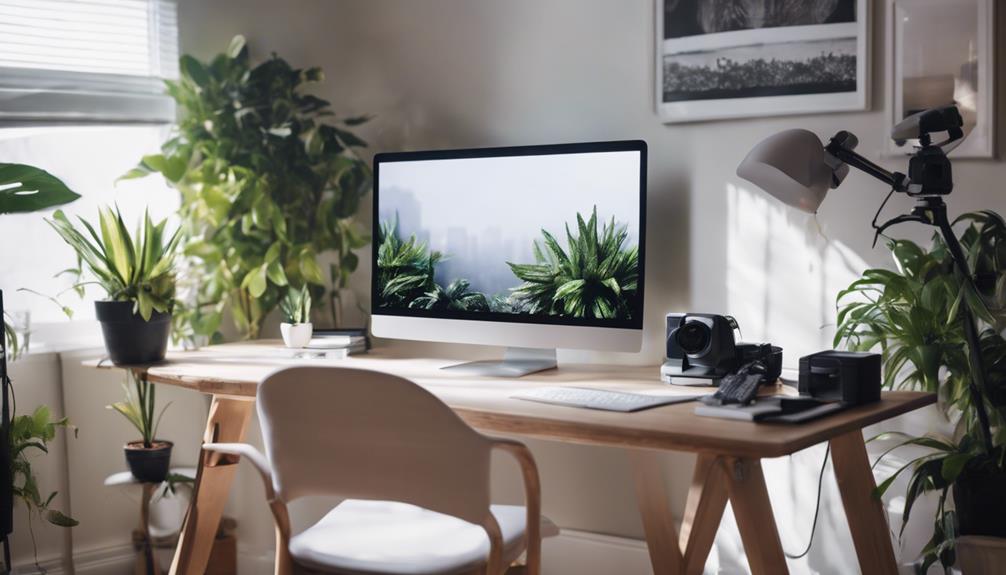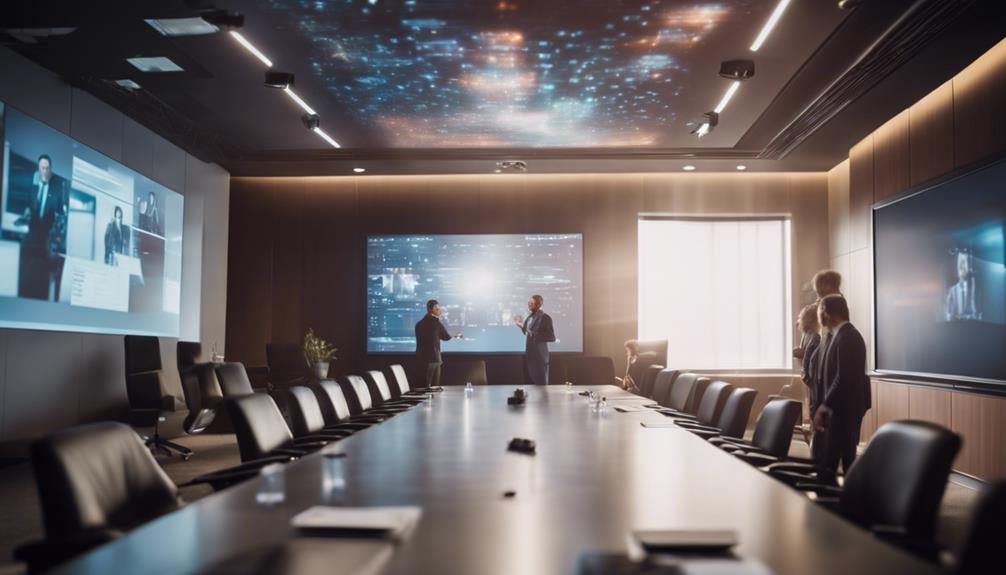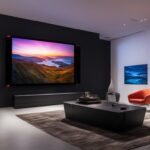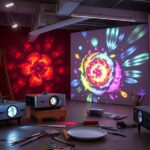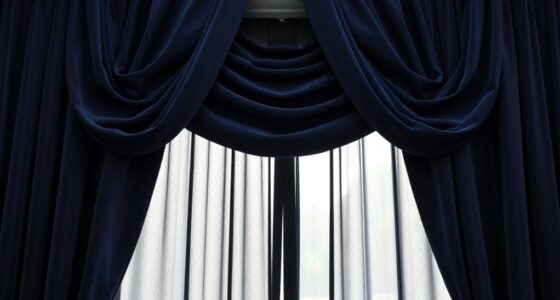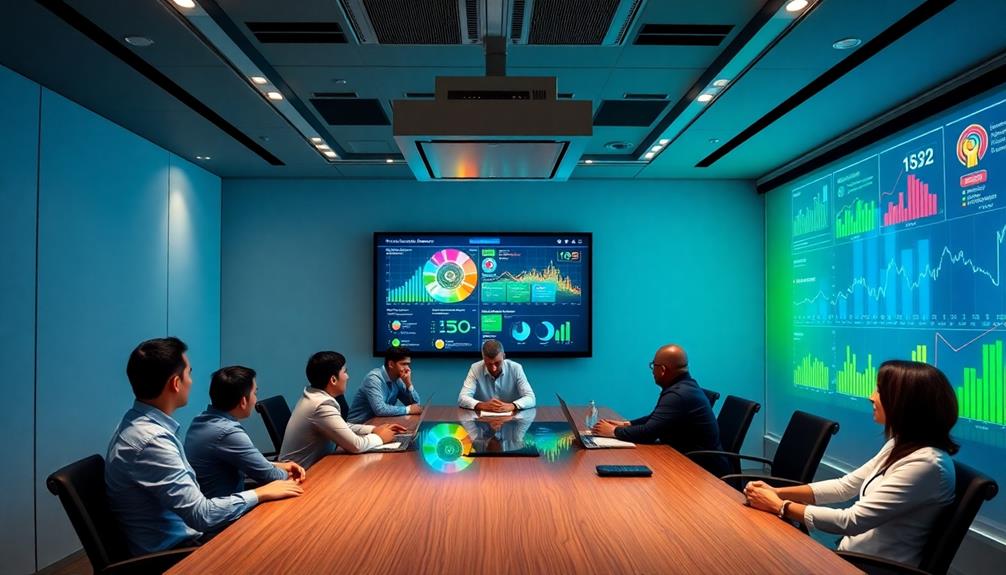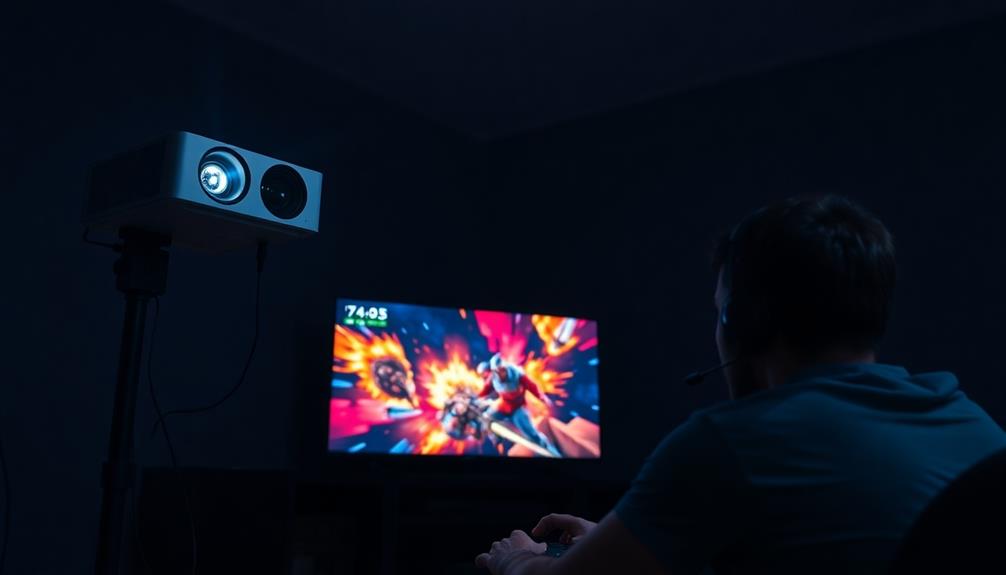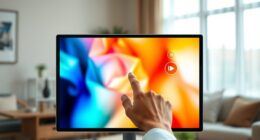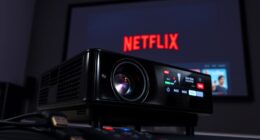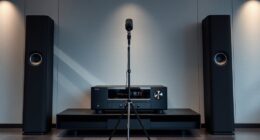When you're searching for the best projectors for your home office, focus on models with at least 2,500 ANSI lumens for bright environments. Look for DLP or 3LCD projectors for sharp colors and clarity. The Epson Pro Cinema LS12000 and BenQ TK860i are excellent choices, offering vibrant images and strong contrast. If you're on a budget, consider the Vankyo Performance V700W, which combines good performance with affordability. Portable options like the Anker Nebula Capsule II are great for flexibility. Stay tuned for tips on features and accessories that can further enhance your home office setup!
Key Takeaways
- Aim for projectors with at least 2,500 ANSI lumens for clear visibility in well-lit home office environments.
- Choose models with 1080p resolution or higher for sharp text and visuals during presentations.
- Ensure diverse connectivity options, including multiple HDMI ports and wireless capabilities, for seamless device integration.
- Consider projectors with built-in speakers and high contrast ratios for enhanced audio-visual experiences in presentations.
Projector Types for Home Office
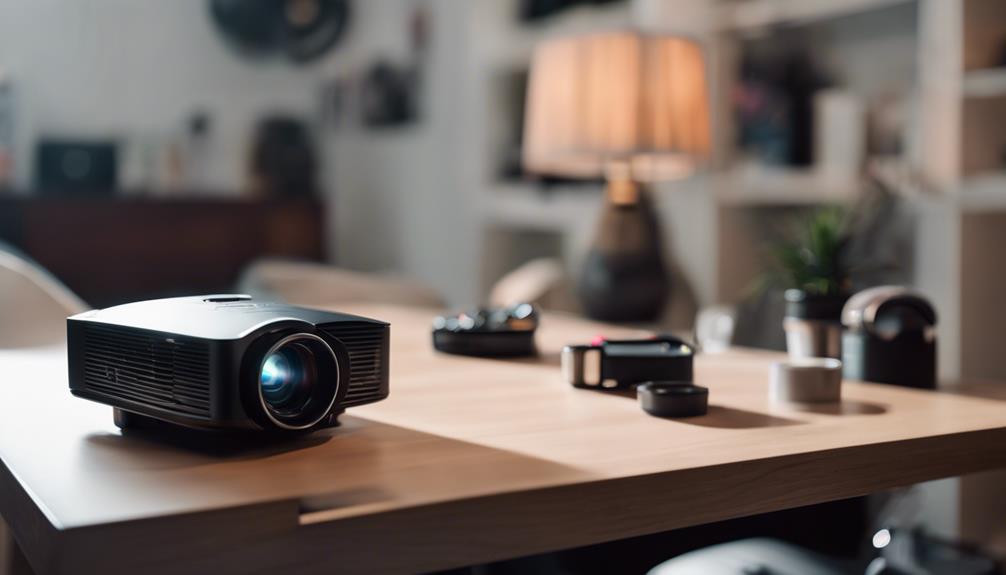
When setting up your home office, choosing the right type of projector can greatly enhance your productivity and presentation quality. You have several options to evaluate, each with unique advantages.
DLP projectors deliver sharp images and excellent color accuracy, making them ideal for detailed presentations.
If your office has ambient light, 3LCD projectors are a fantastic choice; their vibrant color reproduction guarantees that your visuals remain clear and engaging.
For smaller spaces, short-throw projectors project large images from just a few feet away, allowing you to maximize your available area.
If you need flexibility, portable projectors are perfect. Their compact design lets you easily move them between rooms or take them with you for on-the-go presentations.
Lastly, evaluate laser projectors. They offer higher brightness levels and a longer lifespan than traditional bulb projectors, making them a reliable option for consistent performance over time.
Key Features to Consider
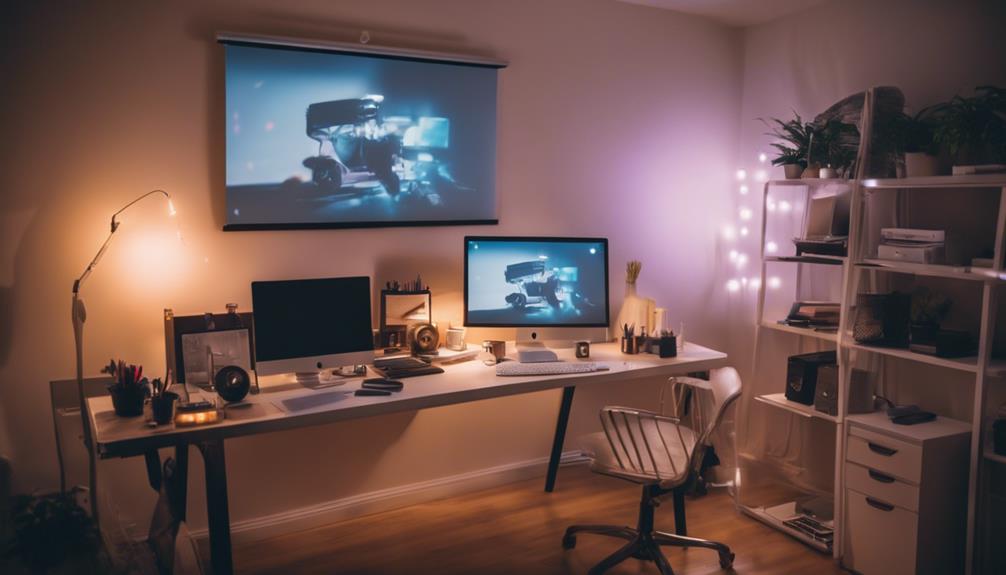
When choosing a projector for your home office, you'll want to focus on several key features that impact performance.
Brightness and resolution play a significant role in guaranteeing clear images, especially during presentations.
Additionally, consider connectivity options to assure compatibility with your devices, making your work setup as seamless as possible.
A well-optimized home theater setup can enhance your productivity and viewing experience.
Moreover, look for projectors that offer features like built-in speakers or compatibility with external audio systems for improved sound quality during video conferences.
Resolution and Clarity
For your home office, selecting a projector with a minimum resolution of 1080p guarantees that text and visuals remain sharp and clear during presentations.
If you want even better clarity, take into account a 4K projector, which delivers superior image quality and detail, especially on larger screens.
Resolution isn't the only factor to take into account; high contrast ratios, ideally above 10,000:1, greatly improve the distinction between light and dark areas, enhancing readability.
This assures that your audience can easily follow along without straining their eyes.
Also, pay attention to brightness levels. A projector with at least 2,500 ANSI lumens is advisable for home offices with ambient lighting, guaranteeing clear visibility.
This brightness, combined with high contrast, greatly influences image quality.
Lastly, think about color accuracy. DLP projectors are known for delivering better color representation and sharpness, making them a smart choice for professional environments where presentation quality is vital.
Brightness and Ambient Light
Brightness plays an essential role in how well your projector performs in a home office, especially under varying ambient light conditions. For ideal performance, aim for a minimum brightness of 2,500 ANSI lumens. If your workspace is particularly well-lit, consider projectors with brightness levels of 3,000 ANSI lumens or more. This guarantees clear, vibrant images, even during daylight hours.
The contrast ratio is also vital for image clarity. A higher contrast ratio, like 20,000:1, enhances depth and detail in your visuals, making presentations more engaging. When choosing a projector, you might want to look for models that utilize a laser light source. They provide consistent brightness and color accuracy over time, ensuring your images remain sharp regardless of the light conditions.
Additionally, projectors with adjustable brightness settings or Eco modes can greatly enhance usability. These features allow you to fine-tune performance based on ambient light, making it easier to adapt to different lighting scenarios in your home office.
Connectivity and Compatibility
Selecting a projector with diverse connectivity options is essential for guaranteeing it works seamlessly with your home office setup. Look for models that offer multiple HDMI ports, as this will allow you to connect various devices like laptops and streaming devices without hassle.
Additionally, consider projectors with USB-C connectivity, which simplifies the connection process for newer laptops and smartphones, making it easier to project presentations directly.
Wireless capabilities are another key feature to look for. Many modern projectors support screen mirroring technologies like Miracast and AirPlay, allowing you to connect your devices without the clutter of cables. This flexibility enhances your productivity during meetings.
Moreover, verify the projector's compatibility with popular software applications, such as Zoom or Microsoft Teams. Some models come with built-in support, streamlining your virtual meetings.
Lastly, don't overlook Bluetooth capabilities. A projector with Bluetooth allows for wireless audio streaming to external speakers, greatly improving the audio quality during presentations or video calls.
Top Projector Recommendations
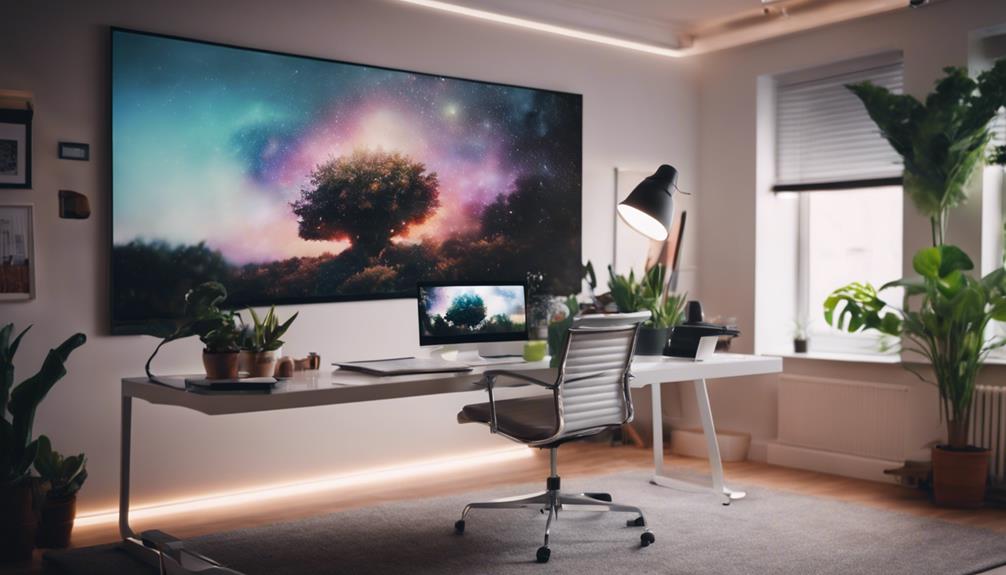
When choosing a projector for your home office, you'll want to take into account brightness levels, resolution, and connectivity options.
Each of these factors plays an essential role in ensuring your presentations are clear and engaging.
Let's take a closer look at some top recommendations that excel in these areas.
Ideal Brightness Levels
Achieving ideal visibility in a home office requires projectors that deliver at least 2,500 ANSI lumens, ensuring your presentations remain clear and engaging, even in well-lit spaces.
You'll want to evaluate options like the Epson Pro Cinema LS12000, which offers a brightness level of 2,700 lumens. This projector not only handles bright rooms well but also delivers stunning 4K images that enhance your visuals.
Another excellent choice is the BenQ TK860i, boasting 3,000 lumens. It provides vibrant colors and strong contrast, making it perfect for various lighting conditions in your home office.
If you're working in a larger space or dealing with considerable ambient light, the Epson PowerLite L630U stands out with its impressive 6,200 ISO lumens, ensuring your display remains clear no matter the environment.
For those on a budget, the Vankyo Performance V700W is a solid option, offering 4,000 lumens without breaking the bank. This projector balances affordability with adequate brightness, making it a practical choice for home office setups.
With these options, you can be sure your projector will meet your brightness needs.
Resolution Considerations
How can you confirm your presentations stand out? Consider a projector with at least 1080p resolution for sharp, detailed images that enhance your home office experience.
With a 1080p projector, you'll enjoy clear visuals that make your content more engaging and easier to follow.
If you're aiming for the highest image quality, investing in a 4K projector can elevate your presentations even further. Models like the Epson Pro Cinema LS12000, boasting a resolution of 3840 x 2160, provide stunning detail and vibrant colors.
The BenQ TK860i is another excellent choice with 4K capabilities and great contrast, making it user-friendly for various office tasks.
For those on a budget, the Vankyo Performance V700W delivers decent 1080p resolution at an affordable price, ideal for casual office use.
Remember to prioritize projectors with at least 2,500 lumens to guarantee visibility in different lighting conditions. This consideration is essential, especially if your home office has bright surroundings.
Connectivity Options Explained
Understanding the connectivity options available on projectors is essential for creating a seamless home office setup that enhances productivity. When choosing a projector, consider how you'll connect your devices. Look for models that offer HDMI input for easy connections with laptops and streaming devices.
Here's a quick comparison of top projectors based on their connectivity options:
| Projector | Connectivity Options | Wireless Capabilities |
|---|---|---|
| Epson Pro Cinema LS12000 | HDMI, USB, Multiple Connectivity | Yes |
| BenQ TK860i | HDMI, USB | No |
| Anker Nebula Mars 3 | HDMI, Wireless Mirroring | Yes |
| Hisense C1 | HDMI, VGA, USB | No |
| Vankyo Performance V700W | HDMI, USB | Limited |
For those seeking a portable projector, the Anker Nebula Mars 3 stands out with its wireless capabilities, making screen sharing a breeze. If you're on a budget, the Vankyo Performance V700W offers multiple connectivity options without breaking the bank. Make sure to evaluate these features based on your specific home office needs!
Best Budget Projectors
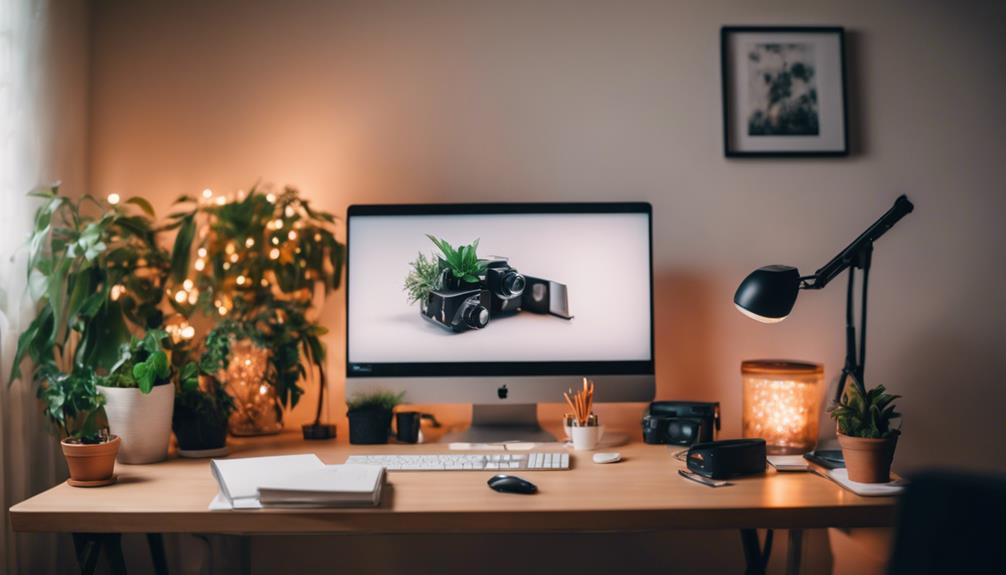
When you're looking for the best budget projectors, several options stand out for their performance and affordability.
The Vankyo Performance V700W is a top choice, providing excellent performance and decent brightness at an affordable price point. If you're willing to spend a bit more, the BenQ HT2060 offers bright images and is suitable for large screens, making it a great investment under $1,000.
For home office use, consider the Epson EpiqVision Flex CO-FH02, which features 1080p resolution and an impressive 3,000 lumens of brightness, all for around $599. Another strong contender is the ViewSonic PS502W, priced at approximately $550, delivering 4,000 lumens and performing well in various lighting conditions.
If you need a compact and portable projector, the AAXA P8 is an excellent option for under $250. While it lacks a built-in battery and streaming apps, it still offers decent performance for budget-conscious users.
These best budget projectors prove you don't have to break the bank to find a reliable, high-quality projector for your home office needs.
Best Portable Projectors

For professionals on the move, finding the best portable projectors can enhance your presentations with convenience and quality.
The Anker Nebula Capsule II Mini stands out with its compact design and 720p native resolution, making it perfect for on-the-go use. With built-in Android TV, you can easily access content without needing additional devices.
Another excellent option is the Optoma ML750e, weighing only 380g. It offers 700 lumens of good brightness, which is ideal for less-than-dark environments, and features multiple connectivity options like HDMI and USB.
If you prefer a lightweight solution with wireless capabilities, the LG Minibeam PH550G is a great choice, also providing 720p resolution and 550 lumens.
For those who need durability, the Nebula Mars 3 is weatherproof and delivers impressive 1080p resolution along with long battery life, ensuring you're covered for both indoor and outdoor presentations.
Setup and Installation Tips
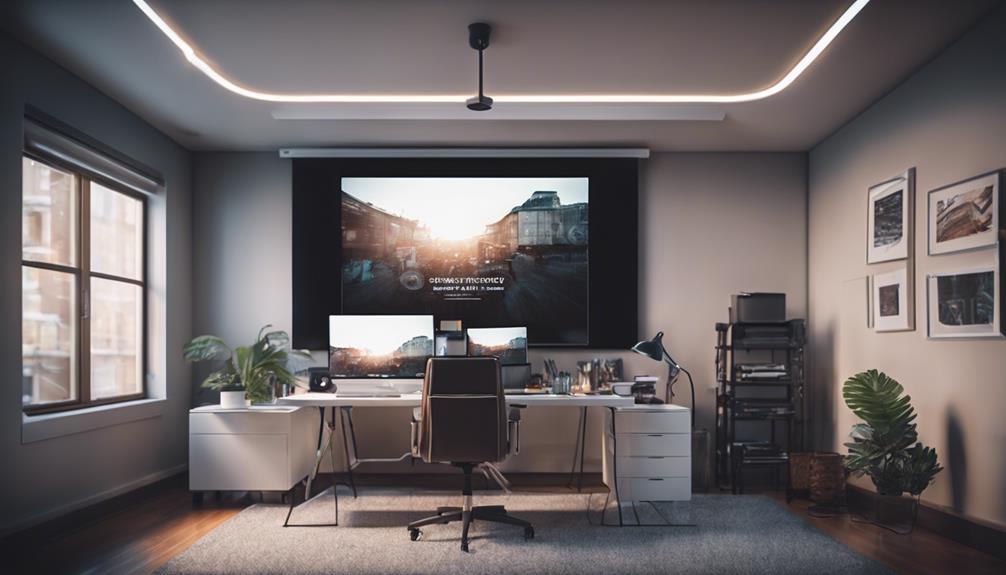
Setting up your projector correctly is key to maximizing your home office presentations and guaranteeing a professional appearance. Follow these tips for an ideal installation:
- Throw Distance: Place the projector at the appropriate throw distance, typically 1.5 to 2.5 times the width of your projector screen. This will help achieve the best image size and clarity.
- Quality Surface: Use a high-quality projector screen or a matte-finished wall. This enhances image quality and reduces glare, making your presentations more effective.
- Stable Mount: Secure your projector on a stable mount or surface. This prevents vibrations that can distort the image, guaranteeing a crisp display during your meetings.
- Connect Properly: Confirm you connect the projector to a reliable power source and use high-quality cables. This prevents signal loss and degradation, which can compromise brightness and overall performance.
Accessories for Optimal Use
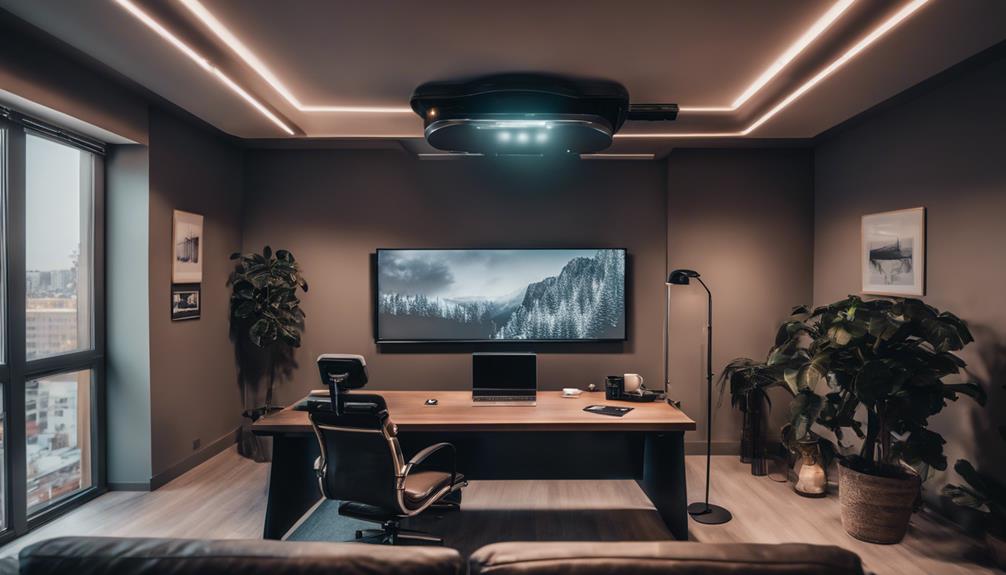
Enhancing your home office setup with the right accessories can greatly improve your projector's performance and your overall presentation experience.
Start by investing in a high-quality projector screen, like the Silver Ticket STR Series, to boost image clarity and color accuracy during video conferencing.
Pair this with a reliable projector mount, such as the Peerless-AV PRGS-UNV, to secure your projector and guarantee ideal viewing angles, reducing neck strain during long sessions.
Don't overlook audio quality; an external sound system can make a world of difference. Most projectors come with limited built-in sound, so upgrading can enhance your presentations considerably.
To facilitate smoother shifts, consider using a wireless presentation remote, which allows you to move freely and engage with your audience more effectively.
Performance Evaluation Criteria
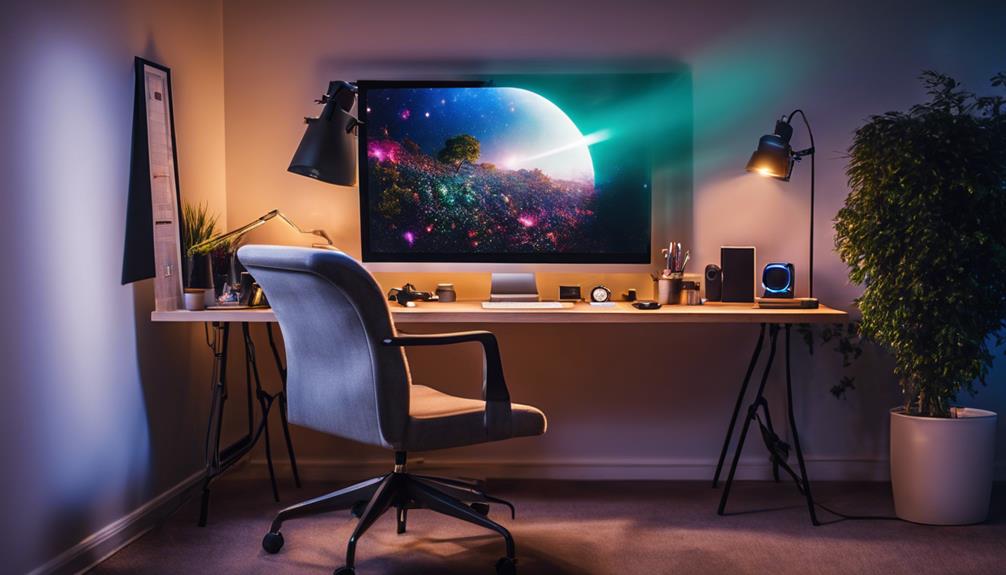
When evaluating projectors for your home office, consider key performance criteria like brightness, resolution, and connectivity options to confirm they meet your specific needs. Here's what to focus on:
- Brightness: Aim for a minimum of 2,500 ANSI lumens. This guarantees clear visibility even in well-lit environments, preventing eye strain during long hours.
- Resolution: Look for at least 1080p resolution, or even 4K if you need high image fidelity. This will enhance your presentations and make text easier to read.
- Contrast Ratio: A contrast ratio of at least 10,000:1 is vital. It makes images pop and helps distinguish between text and graphics effectively.
- Connectivity Options: Multiple options like HDMI, USB, and wireless capabilities are essential. This versatility allows you to connect various devices seamlessly in your home office.
Also, consider portability—a lightweight design under 5 pounds makes it easy to move the projector between different workspaces.
Current Deals and Discounts

Right now, you can find great deals on a variety of projectors perfect for your home office needs.
If you're looking for a compact option, the Epson EF-100 is available for $799.99, down from $999.99. It's a solid choice for good performance without taking up too much space.
For those who need portability, the Anker Nebula Capsule 3 Laser is now priced at $699.99, previously $799.99, making it ideal for presentations on the go.
If you're after high-quality visuals, consider the Optoma UHD38x, currently listed at $1,099.40, considerably lower than its original price of $1,449. This projector offers excellent 4K resolution, perfect for detailed work.
The LG HU810PW is another premium choice, priced at $2,792.12, down from $2,999.99, ensuring high-quality image performance.
Finally, the ViewSonic LX700-4K is available for $1,439.99, reduced from $1,599.99, providing reliable 4K capabilities for professional settings.
Don't miss out on these discounts to elevate your home office experience!
Frequently Asked Questions
What Is the Best Projector for Working From Home?
When choosing the best projector for working from home, consider brightness, resolution, and portability. You'll want a model that fits your space and enhances your presentations while being easy to set up and use.
What Is the Difference Between a Home Projector and a Business Projector?
Did you know that home projectors can boast contrast ratios over 100,000:1? While home projectors focus on rich visuals, business projectors prioritize brightness and portability, ensuring clear presentations in varied lighting conditions.
How Many Lumens Do I Need for an Office Projector?
You'll need at least 2,500 ANSI lumens for a well-lit office to guarantee clear visibility. In darker settings, 1,000 to 1,500 lumens might suffice, but consider your screen size and ambient light for best results.
How Do I Choose a Projector for My Office?
Did you know brighter projectors, with at least 2,500 ANSI lumens, enhance visibility in well-lit spaces? To choose one, consider brightness, resolution, connectivity, contrast ratio, and portability to meet your specific office needs.
Conclusion
In choosing the right projector for your home office, remember that it's not just about brightness or resolution; it's about enhancing your productivity and creativity.
With the right features and setup, you can transform your workspace into a dynamic hub of inspiration.
So, whether you're on a budget or need something portable, there's a perfect projector waiting for you.
Don't just work—work smarter, and watch your ideas come to life on the big screen!
